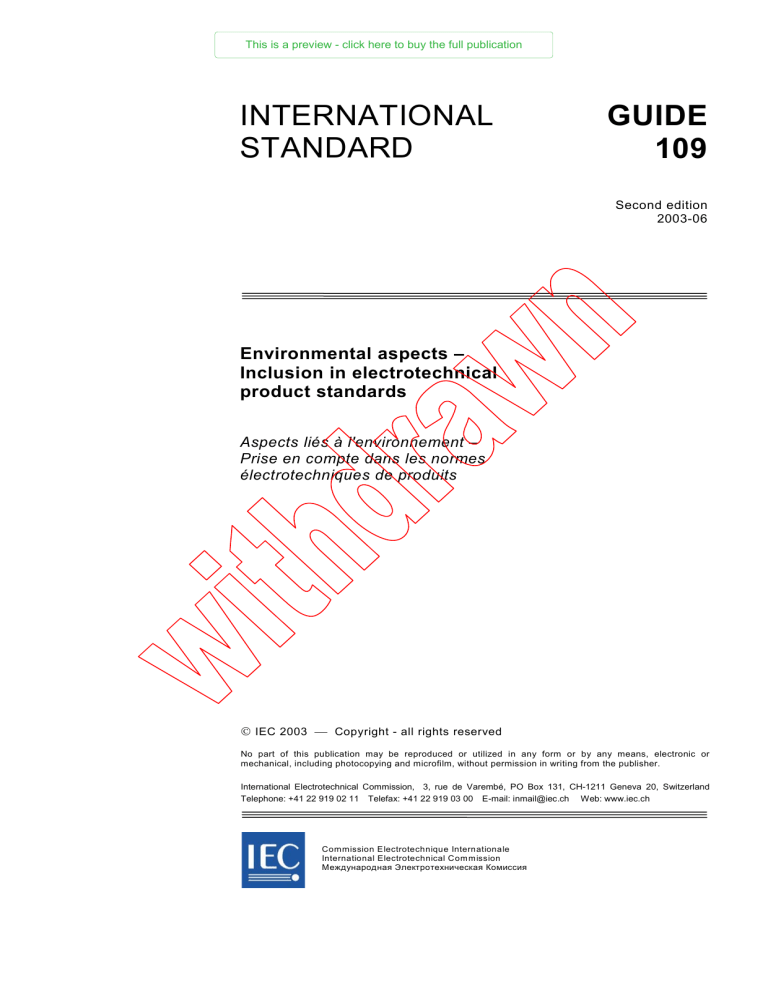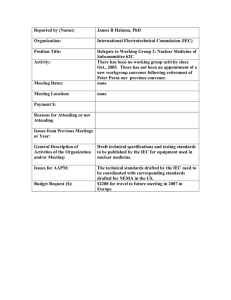INTERNATIONAL STANDARD GUIDE 109

This is a preview - click here to buy the full publication
INTERNATIONAL
STANDARD
GUIDE
109
Second edition
2003-06
Environmental aspects –
Inclusion in electrotechnical product standards
Aspects liés à l'environnement –
Prise en compte dans les normes
électrotechniques de produits
IEC 2003 Copyright - all rights reserved
No part of this publication may be reproduced or utilized in any form or by any means, electronic or mechanical, including photocopying and microfilm, without permission in writing from the publisher.
International Electrotechnical Commission, 3, rue de Varembé, PO Box 131, CH-1211 Geneva 20, Switzerland
Telephone: +41 22 919 02 11 Telefax: +41 22 919 03 00 E-mail: inmail@iec.ch Web: www.iec.ch
Commission Electrotechnique Internationale
International Electrotechnical Commission
Международная Электротехническая Комиссия
PRICE CODE
For price, see current catalogue
M
This is a preview - click here to buy the full publication
– 2 –
INTERNATIONAL ELECTROTECHNICAL COMMISSION
___________
ENVIRONMENTAL ASPECTS –
INCLUSION IN ELECTROTECHNICAL PRODUCT STANDARDS
FOREWORD
GUIDE 109 IEC:2003(E)
This second edition of IEC Guide 109 has been prepared, in accordance with the procedure given in Annex A of Part 1 of the ISO/IEC directives, by the IEC Advisory Committee on
Environmental Aspects (ACEA).
The text of this Guide is based on the following documents:
Approval document
C/1289/DV
Report on voting
C/1304A/RV
Full information on the voting for the approval of this Guide can be found in the report on voting indicated in the above table.
IEC Environmental Policy
“IEC recognizes the growing importance of preserving the environment and the role electrotechnical standardization has to play to foster sustainable development. Therefore it is the responsibility of IEC staff and technical committees, members and experts, to contribute actively to the evolving standards framework for the benefit of the environment.
For this purpose, the IEC cooperates with ISO and regional standards development organizations such as CENELEC. With respect to product-related standards, IEC technical committees must assess and continuously improve new and existing standards in view of reducing adverse environmental impacts over the whole life cycle of products. The IEC will monitor and annually report progress according to this policy.”
The IEC Environmental Policy has been approved by the IEC Council Board. IEC Guide 109 helps to fulfil this policy by illustrating how environmental aspects can be included in electrotechnical product standards.
This is a preview - click here to buy the full publication
GUIDE 109 IEC:2003(E) – 3 –
INTRODUCTION
This Guide aims to give advice to standards writers on the way the environment should be considered among all the aspects relevant to standards.
Finding an appropriate solution for the product is the task of product designers; this solution will be a trade-off along various dimensions (safety, environment, cost, technology, function and so on). This Guide is intended for standards writers, not for product designers; it aims at encouraging standards which preserve the natural environment while allowing designers to reach the best practical compromise among the constraints.
The need to reduce the adverse impacts on the natural environment of a product * during all phases of its life – from acquiring materials to manufacturing, distribution, use, and end-of-life treatment (i.e. re-use, recycling (recovery and disposal)) – is recognized in most countries around the world. The choices made at the design stage largely determine what those impacts will be during each phase of the life of that product. There are, however, considerable obstacles that make the task of selecting the best environmental options very complex. For example, selecting design options to reduce adverse environmental impacts can involve difficult trade-offs such as less recyclability for more energy efficiency.
Requirements for products may influence significantly the extent of environmental effects.
Standards should promote the selection of design options in order to reduce adverse impacts.
Furthermore, standards must not prohibit innovation in any sense. Standards writers should encourage the protection of the environment, for instance, by specifying requirements which do not rule out the appropriate use of recycled material and the re-use of components, subsystems and systems.
The continual introduction of new products and materials can make evaluation increasingly complex, since additional data must be gathered to assess the life-cycle impacts of such new products and materials. Moreover, there is currently very little data available on the environmental impacts of some existing materials. However, the data which exists can be used as a basis for improvement of the products with respect to environmental impacts. Life-
Cycle Assessment (LCA) and Design For Environment (DFE) – or rather Environmentally
Conscious Design (ECD)** – principles provide additional instruments that may be useful in this respect. ISO/TR 14062 gives all those involved information on how to integrate ECD principles into product design and development. Standards writers are not expected to perform Life-Cycle Assessment (LCA) but to encourage ECD.
Until more data are available, manufacturers can document more extensively the specific design choices and the reasons behind them. Besides generating requirements for environment-specific standardization, doing this expands the knowledge based on such options and choices, and it may also assist recycling and disposal at the End of Life of the product (EOL).
In this context, it should be noted that a standards writer should also give careful consideration to their impacts on the environment when specifying test methods.
Standards writers need comparative environmental data on materials and substances.
However, they should handle information derived from LCA studies with great care when making choices needed for a standard. This may require consultation with advisory committees on environmental aspects within national, regional and international standards bodies.
___________
*
Although the term product has been used throughout this Guide, the concept also embraces processes and services as appropriate.
** For the process of integrating environmental aspects into product design and development, various terms are used such as Design For Environment (DFE), eco-design, Environmentally Conscious Design (ECD), etc. ECD will be used in this document to represent the various terms.
This is a preview - click here to buy the full publication
– 4 –
ENVIRONMENTAL ASPECTS — INCLUSION IN ELECTROTECHNICAL
1 Scope
PRODUCT STANDARDS
GUIDE 109 IEC:2003(E)
IEC Guide 109 is intended for standards writers and gives guidance on how to consider aspects relating to the impact on the environment of electrotechnical products when preparing standards for such products.
Its purpose is a) to raise awareness that provisions in product standards can affect the environment in both negative and positive ways; b) to outline the relationship between product standards and the environment; c) to help avoid provisions in product standards that may lead to adverse environmental impacts; d) to emphasize that addressing environmental aspects during the development of product standards is a complex process and requires balancing competing priorities; e) to recommend the use of life-cycle thinking when addressing environmental aspects in the context of product standardization.
This Guide converges as far as possible with ISO Guide 64.
ISO 14001:1996, Environmental management systems – Specification with guidance for use
ISO/TR 14062:2002, Environmental management – Integrating environmental aspects into product design and development
ISO 11469:2000, Plastics – Generic identification and marking of plastics products
ISO 14040:1997, Environmental management – Life cycle assessment – Principles and framework
ISO 17422:2002, Plastics – Environmental aspects – General guidelines for their inclusion in standards
ISO Guide 64:1997, Guide for the inclusion of environmental aspects in product standards
ISO/IEC Guide 2:1996, Standardization and related activities – General vocabulary
3 Definitions
For the purposes of this Guide, the following definitions apply.
3.1
End of Life (EOL) state of a product when it is finally removed from its intended use or original purpose





